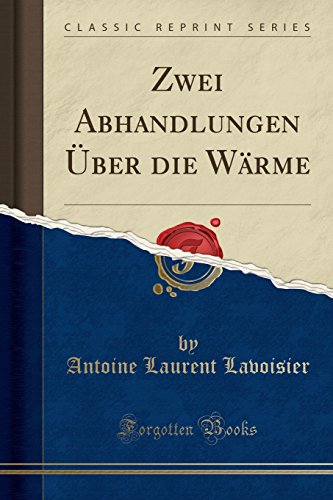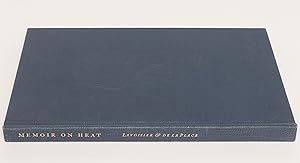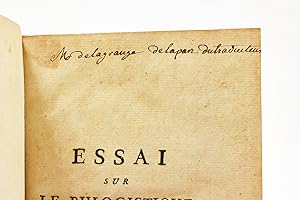Antoine Lavoisier Pierre Simon Laplace (8 results)
Product Type
- All Product Types
- Books (8)
- Magazines & Periodicals
- Comics
- Sheet Music
- Art, Prints & Posters
- Photographs
- Maps
-
Manuscripts &
Paper Collectibles
Condition
Binding
Collectible Attributes
Seller Location
Seller Rating
-
Mémoire sur la chaleur
Published by Gauthier-Villars, Paris, 1920
Seller: Sheila B. Amdur, Coventry, CT, U.S.A.
Book
Tan Decorated Card Covers. Condition: Near Very Good. 78 pp with 2 plates. Light crease lower right corner. Outer tips spotted, contents clean, tight.
-
Zwei Abhandlungen à ber die Wärme (Classic Reprint)
Published by Forgotten Books, 2024
ISBN 10: 1390094030ISBN 13: 9781390094039
Seller: Forgotten Books, London, United Kingdom
Book Print on Demand
Paperback. Condition: New. Print on Demand. Excerpt from Zwei Abhandlungen à ber die Wärme. About the Publisher, Forgotten Books publishes hundreds of thousands of rare and classic books. This book is a reproduction of an important historical work. Forgotten Books uses state-of-the-art technology to digitally reconstruct the work, preserving the original format whilst repairing imperfections present in the aged copy. In rare cases, an imperfection in the original, such as a blemish or missing page, may be replicated in our edition. We do, however, repair the vast majority of imperfections successfully; any imperfections that remain are intentionally left to preserve the state of such historical works. This text has been digitally restored from a historical edition. Some errors may persist, however we consider it worth publishing due to the work's historical value. The digital edition of all books may be viewed on our website before purchase. print-on-demand item.
-
Mémoire sur la Chaleur.
Publication Date: 1920
Seller: Antiq. F.-D. Söhn - Medicusbooks.Com, Marburg, Germany
Book
Paris, Gauthier-Villars, 1920, 12°, 78 pp., 2 Taf., orig. Broschur. These workers invented an ice calorimeter, with it measured the respiratory quotient of a pig, and demonstrated the analogy between respiration and combustion. Garrison & Morton.
-
Paris, Gauthier-Villars, 1920. In-12, broché, couverture imprimée, 78 p., 2 planches hors texte in fine. Dans la collection "Les maîtres de la pensée scientifique". (Duveen & Klickstein, n° 222). Très bon exemplaire, très frais à l'état de neuf.
-
Memoir on Heat: Read to he Royal Academy of Sciences 28 June 1783
Published by Neale Watson Academic Publications, New York, 1982
ISBN 10: 0882021958ISBN 13: 9780882021959
Seller: Zed Books, New York, NY, U.S.A.
Book
Hardcover. 8vo. Blue cloth. Near Fine. Slight shelfwear to boards. English language translation with a facsimile of the French edition with introduction and notes by the translator, Henry Guerlac. Subtle erasure mark to front free endpaper.
-
Helmstädt und Leipzig, J.G. Müllerschen Budhhandlung, 1787. Small 8vo. Orig. printed blue wrappers. In: "Chemische Annalen.von Lorenz Crell", 1787, 2. Bd., 7. Stück. Pp. 1-95 (the entire issue (Stúck 7) offered). Lavoisier & La place's paper: pp. 62-94. First appearance in German of the fourth part of of the classic joint paper "Mémoir sur la Chaleur", published 1783, which contains the section on combustion and respiration."Few collaborations in the history of science can equal, for the eminence of the two participants, that between the coryphaeus of the Chemical Revolution, Antoine-Laurent Lavoisier, and his collegue in the Royal Academy of Science, the mathematical physicist, Pierre-Simon de Laplace. We remember this collaboration chiefly, if not solely, for the famous investigatuon on Calorimetry, which resulted in one of the aknowledged classics of science, the joint "Mémoir sur la Chaleur", pulished in the Histoire et Mémoires of the Academy of Sciences in 1784."(Henry Guerlac).
-
Lavoisier und de la Place über die Wärme (pp.263-273, 344-363, 546-563,; 62-84).
Publication Date: 1787
Seller: Antiq. F.-D. Söhn - Medicusbooks.Com, Marburg, Germany
Book
Crells Chem. Annalen, 1787/ 3+4+6; 1787/ 1. - Helmstädt, Leipzig, Müller 1787, pp.195-384, 483-574, 96 pp., 4 Broschur. This most important memoir by Lavoisier and Laplace was based on work done in the winter of 1782-83. The paper was read before the Académie on June 18, 1783. An ice calorimeter of their own invention was employed to measure specific heats and the heat evolved in combustion and respiration. In their experiements with guinea pigs, Lavoisier and Laplace demonstrated that respiration is in every way a very slow combustion process, and that chaleur animale is constantly beeing maintained by means of 'matière du feu' which is produced during respiration. Duveen & Klickstein I, p.54f. and: Lavoisier zwote Abhandlung über verschiedene Verbindungen der Phosphorsäure (S.254-258). "This memoir was read on November 18, 1780. It is concerned with the compounds of phosphoric acid. Lavoisier refers to oxygen in this publication as air vital. " Duveen & Klickstein, p.53 Lavoisier über ein besonderes Verfahren, Phosphor ohne Verbrennen in Phosporsäure zu verwandeln (S.259-262). Lavosier points out in this paper that, if it was correct that phosphorus on burning yieled its acid through combinantion with atmospheric oxygen was induced to react with it. He state that, theorectically, nitric acid should be adequate for this purpose and describes the solution of phosphorus in hot nitric acid to give phosphoric acid. Lavoisier follows up his account with another attack on the phlogistan theory." Duveen & Klickstein I, p.54 Duveen 55 (externsice abstract), 54 (abstract), 55 (abstract).
-
Essai sur le Phlogistique, et sur la constitution des Acides
Published by S.n., 1788
Book First Edition Signed
Couverture rigide. - S.n., Paris 1788, in-8 (12,5x20cm), xij ; 344 pp.; (4 p.), relié. - Edition originale et unique parution de la traduction et analyse critique par les plus grands scientifiques français sous la direction de Mme Lavoisier de ce texte publié en anglais l'année précédente sous le titre An Essay on Phlogiston and the Constitution of Acids. L'ouvrage est constitué de douze sections, toutes suivies de notes critiques par Louis-Bernard Guyton de Morveau, Antoine Laurent Lavoisier, Pierre Simon de La Place, Gaspard Monge, Claude Louis Berthollet et Antoine François de Fourcroy. Reliure de l'époque en demi basane havane, dos lisse orné de filets et fleurons dorés, pièce de titre de maroquin noir, plats de papier à la colle. Mors très habilement restaurés. Intérieur frais hormis deux traces laissées par des signets aux pages 68-69 et 176-177. Rare envoi autographe de Mme Lavoisier à Joseph Louis de Lagrange, illustre mathématicien et fidèle ami de M. Lavoisier. Précieux témoignage du rôle prépondérant que joua Mme Lavoisier dans la « révolution chimique » à l'aube de la Révolution française. Le phlogistique est une théorie chimique apparue à la fin du XVIIème siècle - conçue par Johann Becker et développée par Georg Ernst Stahl - postulant l'existence d'un « élément flamme » inhérent aux corps inflammables et libéré lors de la combustion. Cette hypothèse fut totalement réfutée par Lavoisier qui mit en évidence le rôle de l'oxygène dans le processus de la combustion, créant ainsi la théorie de l'oxydation. Irrité par le scepticisme de Lavoisier à l'égard du phlogistique, l'éminent chimiste irlandais Richard Kirwan publia ce texte intitulé Essay on Phlogiston. « (.) Les chimistes français ralliés à Lavoisier décidèrent de répondre en faisant traduire en français An Essay on Phlogiston. » (Keiko Kawashima, « Madame Lavoisier et la traduction française de l'Essay on phlogiston de Kirwan » in Revue d'histoire des sciences, 2000) Notre ouvrage, loin d'être une simple traduction du travail de Kirwan, emprunte donc la forme d'un véritable manifeste dans lequel les plus grands chimistes du temps s'élèvent contre la théorie phlogistique, déconstruisant un à un les arguments de ses adeptes. L'immense succès de cette traduction française conduit Kirwan à tenter de réfuter les objections de Lavoisier et ses collaborateurs. Il publia en 1789 une deuxième édition de son ouvrage, traduisant les notes françaises de ses détracteurs en anglais et y ajoutant ses propres réfutations. Il se convertit finalement aux idées des antiphlogisticiens, fondatrices de la chimie organique moderne. Marie-Anne Pierrette Paulze - Mme Lavoisier - eut un rôle décisif dans la carrière de son mari qui lui enseigna la chimie à sa demande ; elle devint dès lors son assistante, notant les expériences entreprises par Lavoisier et leurs résultats. Bien vite, elle occupa une place dépassant celle de l'épouse dévouée, devenant traductrice mais également autrice : plusieurs notes de cet Essai sur le phlogistique sont de sa plume. Summum de son implication, c'est elle - en sa qualité d'habile illustratrice - qui dessina toutes les planches du Traité élémentaire de chimie (1789), y apposant cette fois sa signature « Paulze Lavoisier Sculpsit ». Notre exemplaire est enrichi d'un rare envoi autographe « du traducteur » - Mme Lavoisier - à Joseph Louis de Lagrange (1736-1813), l'un des meilleurs amis de son mari. C'est Lavoisier qui aiguisa l'intérêt de Lagrange pour cette nouvelle science qu'était la chimie. Ensemble, ils participèrent à l'élaboration du système métrique uniformisant les poids et les mesures, qui vit le jour durant la Révolution. Travaillant pour le gouvernement révolutionnaire, Lagrange eut plus de chance que son ami chimiste qui, victime de la Terreur, fut exécuté. Apprenant que Lavoisier a été guillotiné, le mathématicien déclara : « Il a fallu un instant pour couper la tête de Lavoisier, et un siècle ne suffira pas pour produire une tête si bien faite ». [ENGLIS xij ; 344 pp.; (4 p.).





